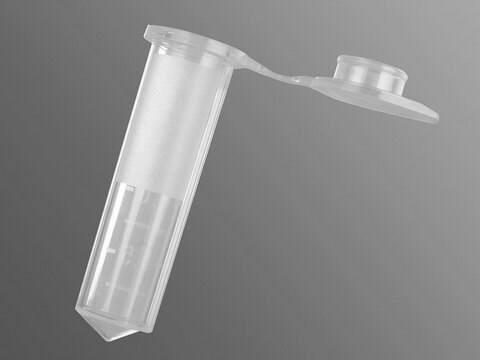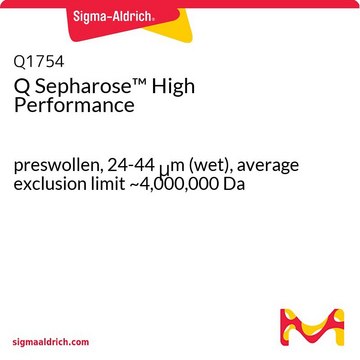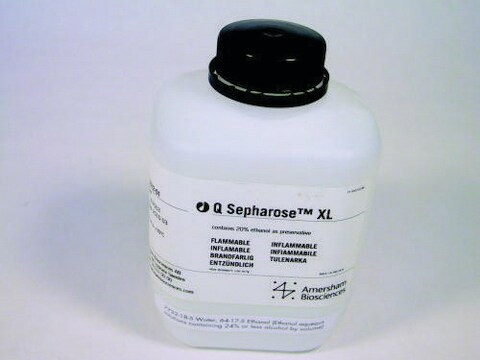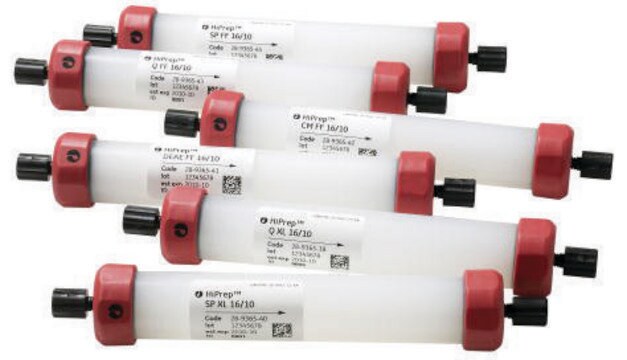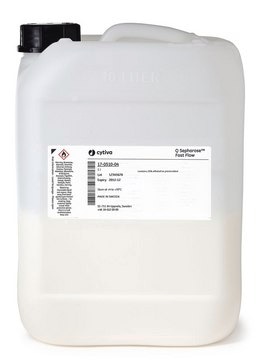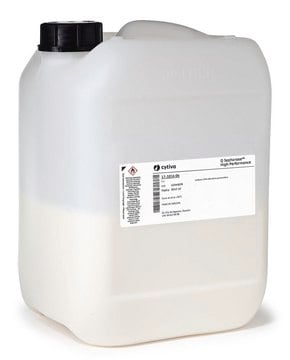Alle Fotos(1)
Wichtige Dokumente
S1799
SP Sepharose™
Fast Flow, aqueous ethanol suspension, 45-165 μm (wet), exclusion limit ~4,000,000 Da
Synonym(e):
Sulfopropyl-Sepharose™
Anmeldenzur Ansicht organisationsspezifischer und vertraglich vereinbarter Preise
Alle Fotos(1)
About This Item
Empfohlene Produkte
Qualitätsniveau
Form
aqueous ethanol suspension
Aktive Matrixgruppe
, —CH2-SO3-
Partikelgröße
45-165 μm (wet)
Porengröße
~4,000,000 Da exclusion limit
Kapazität
180-250 μeq/mL, gel
Lagertemp.
2-8°C
Suchen Sie nach ähnlichen Produkten? Aufrufen Leitfaden zum Produktvergleich
Anwendung
SP Sepharose™ is used in protein chromatography, ion exchange chromatography and cation exchange media. SP Sepharose™ has been used to study inhibitory proteins and peptides from the rhizomes of zingiberaceae plants as well as to study the subunit heterogeneity and molecular evolution of soybean basic 7S globulin. SP Sepharose™ has also assisted with advancing industrial applications of preparation of chitosan oligosaccharides.
Physikalische Form
Suspension in 0.2 M sodium acetate and 20% ethanol
Rechtliche Hinweise
Sepharose is a trademark of Cytiva
Signalwort
Warning
H-Sätze
Gefahreneinstufungen
Flam. Liq. 3
Lagerklassenschlüssel
3 - Flammable liquids
WGK
WGK 1
Flammpunkt (°F)
100.4 - 109.4 °F
Flammpunkt (°C)
38 - 43 °C
Hier finden Sie alle aktuellen Versionen:
Besitzen Sie dieses Produkt bereits?
In der Dokumentenbibliothek finden Sie die Dokumentation zu den Produkten, die Sie kürzlich erworben haben.
Kunden haben sich ebenfalls angesehen
Surachai Supattapone et al.
Methods in molecular biology (Clifton, N.J.), 459, 117-130 (2008-06-26)
The infectious agents of prion diseases are unorthodox, and they seem to be composed primarily of a misfolded glycoprotein called the prion protein (PrP). Replication of prion infectivity is associated with the conversion of PrP from its normal, cellular form
C Y Cheng et al.
Biotechnology and applied biochemistry, 32 ( Pt 3), 197-203 (2000-12-15)
A chitosan-degrading fungus, designated Aspergillus sp. Y2K, was isolated from soil. The micro-organism was used for producing chitosanase (EC 3.2.1.132) in a minimal medium containing chitosan as the sole carbon source. The induced chitosanase was purified to homogeneity from the
Andrei D Shutov et al.
Bioscience, biotechnology, and biochemistry, 74(8), 1631-1634 (2010-08-12)
Basic 7S globulin, a cysteine-rich protein from soybean seeds, consists of subunits containing 27 kD and 16 kD chains linked by disulfide bonding. Three differently sized subunits of the basic 7S globulin were detected and partially separated by SP Sepharose
Maneerat Yodjun et al.
Applied biochemistry and biotechnology, 166(8), 2037-2050 (2012-03-07)
Ammonium sulphate cut protein extracts, and their pepsin hydrolysates, from the rhizomes of 15 plants in the Zingiberaceae family were screened for their in vitro angiotensin I-converting enzyme inhibitory (ACEI) activity. The protein extract from Zingiber ottensii had the highest
James C Geoghegan et al.
The Journal of biological chemistry, 282(50), 36341-36353 (2007-10-18)
The central pathogenic event of prion disease is the conformational conversion of a host protein, PrPC, into a pathogenic isoform, PrPSc. We previously showed that the protein misfolding cyclic amplification (PMCA) technique can be used to form infectious prion molecules
Unser Team von Wissenschaftlern verfügt über Erfahrung in allen Forschungsbereichen einschließlich Life Science, Materialwissenschaften, chemischer Synthese, Chromatographie, Analytik und vielen mehr..
Setzen Sie sich mit dem technischen Dienst in Verbindung.






